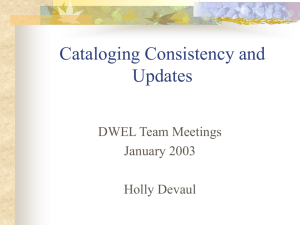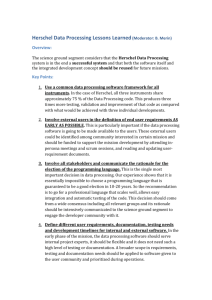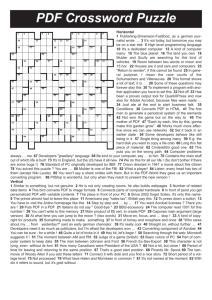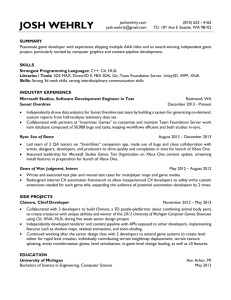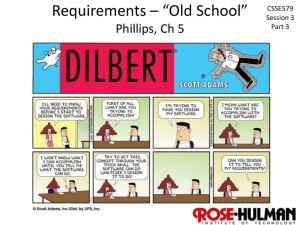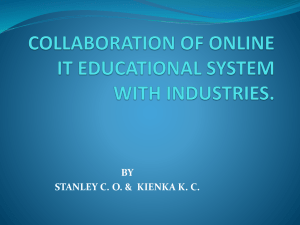Communicative Dimensions of Meta-Design: The Digital Water Education Library Mick Khoo, L3D Meeting
advertisement
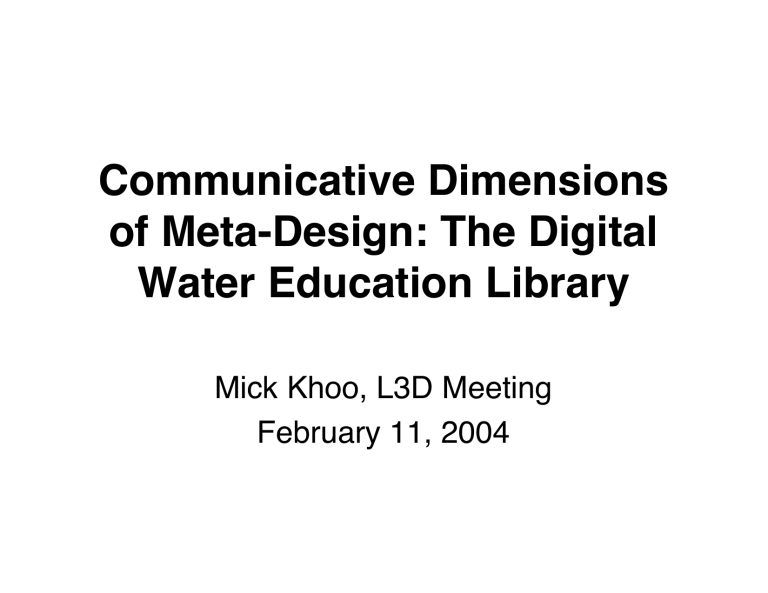
Communicative Dimensions of Meta-Design: The Digital Water Education Library Mick Khoo, L3D Meeting February 11, 2004 Structure • • • • • • • 1. Meta-design and communication 2. Digital Water Education Library 3. Problem 4. Analysis 5. Intervention 6. Outcomes 7. Conclusions Conclusions • Designers, users, and designer-users working together with the same technology, can embrace differing definitions of that technology • In some cases these differences may not be readily apparent to these participants • Meta-design can play a role in the design and support of communication between designers, users, and designer-users 1. Meta-design and Communication Meta-Design & Communication • Meta-design models the involvement of representatives of user communities in the design of artifacts that they will use • ‘User-developers’ mediate between the worlds of developers and users to develop artifacts better suited to their user needs • Implicit in meta-design is a model of communication that assumes that developers, user-developers, and users can talk amongst each other • In reality, how does this communication work? Design Time and Use Time KEY: system developer design time world-as-imagined plannning user (representative) end users use time world-as-experienced situated action Design Time and Use Time KEY: system developer design time world-as-imagined plannning user (representative) end users use time world-as-experienced situated action Design Time and Use Time KEY: system developer design time world-as-imagined plannning user (representative) end users use time world-as-experienced situated action Design Time and Use Time KEY: system developer design time world-as-imagined plannning user (representative) end users use time world-as-experienced situated action Design Time and Use Time KEY: system developer design time world-as-imagined plannning user (representative) end users use time world-as-experienced situated action Meta-Design & Communication • Different groups are involved in MD • These groups can also be heterogenous • Giddens, Ehn, Wittgenstein, Orlikowski suggest that these groups may have different ontological/practical understandings of the artifact • How to maintain and support communication between different groups and understandings? 2. The Digital Water Education Library DWEL • 2 year NSF DL project • 500 exemplary online resources to teach about water in K-12 and informal educational settings • Structuring documents, e.g. scope statement, review criteria • Accessed to DLESE as a complete collection • Using approx. 25 volunteers • Web tools: – Cataloguing tool (DLESE) – WebCT as design environment – E-mail, browsers, etc. DIGITAL LIBRARIES National Science Foundation NSDL DWEL (Other Digital DLESE (Other (Other NSDL Project Investigators (‘PIs’) Library NSF Digital Digital Projects) Library Library Projects) Projects) Advisory Board Educators K-4 Working Group 5-8 Working Group 9-12 Working Group Informal Working Group Leader Leader Leader Leader Member Member Member Member Member Member Member Member Member Member Member Member Member Member Member Member Member Member Institutional context for DWEL Shaded area = WebCT environment DWEL workshops, January 2002 3. The Problem WebCT posts, first 6 months 45 40 35 # posts 30 25 20 15 10 5 0 1 2 3 4 5 6 7 8 9 10 11 12 Week 13 14 15 16 17 18 19 20 21 22 Catalogue records, first 6 months 10 9 8 7 # Records 6 5 4 3 2 1 0 1 2 3 4 5 6 7 8 9 10 11 12 13 14 Week 15 16 17 18 19 20 21 22 23 24 25 26 Initial Actions/Interventions • Questionnaire/survey • Regular PI telecons • Cataloguers are busy people; tasks are complex; more structure required • ‘Buddy system’ • Regular assignments • PI/Working Group Leader telecons Catalogue records, first 6 months 10 9 8 7 # Records 6 5 4 3 2 1 0 1 2 3 4 5 6 7 8 9 10 11 12 13 14 Week 15 16 17 18 19 20 21 22 23 24 25 26 4. The Analysis Centering Resonance Analysis • Form of Latent Semantic Analysis • Focuses on nouns as units of meaning • Clusters nouns based on frequency and relationship to other nouns • Analyses large amounts of org comm • DWEL: Project proposal and other documents, transcripts of 3 days of meetings between developers and users CRA: Use of ‘Resource’ Proposal Fall 2001 EG+TS Resource Collection DWEL Water Student Science Research Project Digital Teacher DLESE Material Advisory Board Meeting January 2002 BA EG Thing Thing Stuff Resource Good People Resource Work People Group Look Right DLESE Different Work Water Catalogue Kind Group Issue Way Sort Level Process RJ Thing Concept Resource People A Way Student Work Topic Literature Kind Level TS Resource Sort Thing People Process Collection DLESE Water Site Metadata Way Point NK Work Group Right Powerful Use Question Tool Teacher Place Background X Research SI Kind Thing Science Work Use Example Project Judge National Year Student Point Working Group Meeting January 2002 BA EG Thing Thing Resource Concept Great Resource Time Type Year Site Student Information Site Good Way Kind Go Level Rule Group Idea Science Information Professional BA+EG+TS Thing Resource Great Site Time Student Year Information Look Group Go Idea Table 1b: Use of words other than ‘resource’ Proposal Advisory Board Meeting AW JV Web Lesson Site Teacher People Child Good Thing Subject Development Activity Test Specific Literature Year Grade Minor Student Developer Fiction Cast Go Point Background Working Group Meeting SV Thing Stuff Science Work Workflow Way Process School Level Just Train Kind All Site Thing Child Teacher Good Group Standard Data Different Student Level Point Initial Analysis (I) • User-developers and developers have different understandings of DLs • User see DLs as bricks-and-mortar libraries that are digitised • Developers see DLs as digital artifacts with certain library-like characteristics (Khoo 2001) Initial Analysis (II) • Use/lack of use of word resource interpreted to mean: • User-developers see DWEL in terms of classroom practice • Developers tend to see DWEL in terms of database, populated with a structured collection of reviewed educational resources described with metadata Analysis (III) • These differences were not apparent to those who attended the January 2002 meeting they had thought that they were in agreement • This suggests that the differences identified by CRA are different practical and ontological framings of DWEL • How to support communication between developer-users and developers, when differences are ontological? • How to represent developer’s frame to userdevelopers? 5. Intervention Intervention: Representing the Project • How to make designer model of DWEL available to user-developers? • Decompose DWEL as an artifact into series of easily understandable components • Represent these components graphically, e.g.: – DWEL as a series of interlinked subject domains that provide full scope coverage – DWEL as a series of tasks linked to the development of those domains over the life of the project Intervention: Representing the Problem • How to make designer model of collection development available to user-developers? • Decompose complex collection devpt process into series of easily understandable steps • Represent these steps graphically Intervention: Designing a solution • Workflow model turned into online tool the DWEL WorkHub - at CSU • Series of linked web pages and forms that guided the educators through the selection, reviewing, cataloguing and metadata generation steps outlined in original graphic Intervention: Implementation • DWEL WorkHub brought online November 2002 • Includes downloadable documentation and instructions January 2003: 2 sets of 2 day training workshops held in computer lab at CSU 6. Outcomes It seemed to work … • … for a while • Cataloguing did not show a huge improvement in productivity, but it did switch from ‘boom and bust’ cycle to a steady accumulation of records DWEL Catalogue records, cumulative 300 New instructions 250 200 # Records 2003 Workshops 150 100 50 0 1 5 9 13 17 21 25 29 33 37 41 45 49 53 Week 57 61 65 69 73 77 81 85 89 93 97 101 Records Catalogued as % of goal 100 New instructions 90 2003 Workshops 80 % of goal achieved 70 60 50 40 30 20 10 0 1 5 9 13 17 21 25 29 33 37 41 45 49 53 Week 57 61 65 69 73 77 81 85 89 93 97 101 Lessons Learned • At the original workshops of January 2002, it was assumed that the tools required for the project were the cataloguing and discussion tools • Regarding the necessity of scope documents and review criteria, it was assumed that communication had occurred between developers and user-developers; and that the user-developers had understood these necessities Design Time and Use Time KEY: system developer design time world-as-imagined plannning user (representative) end users use time world-as-experienced situated action Lessons Learned • Such communication had not occurred however (see CRA), and the developer-users had not understood the importance of developing collection scope and review criteria prior to collecting • This led to low project productivity • CRA suggested that the developers and developer users thought of DWEL in different ways • The DWEL WorkHub incorporated developer thinking regarding review and scope and made this accessible to the developer-users in the form of a structured online workflow tool Lessons Learned • It was a mistake to assume that the userdevelopers could come to a nuanced understanding of all dimensions of collection development on their own • They had to be supported to come to such understandings by the tools (if indeed they developed such understandings at all … maybe they just wanted to do their jobs) Conclusions • Designers, users, and designer-users working together with the same technology, can embrace differing definitions of that technology • In some cases these differences may not be readily apparent to these participants • Meta-design can play a role in the design and support of communication between designers, users, and designer-users QUESTIONS? DWEL workshops, January 2002 UserDevelopers Developers Developers UserDevelopers Users ✓ ✓ ✓ Users UserDevelopers Developers Developers UserDevelopers Users ✓ ✓ ✓ Users UserDevelopers Developers Developers UserDevelopers Users ✓ ✓ ✓ Users UserDevelopers Developers Developers UserDevelopers Users ✓ ✓ ✓ Users
